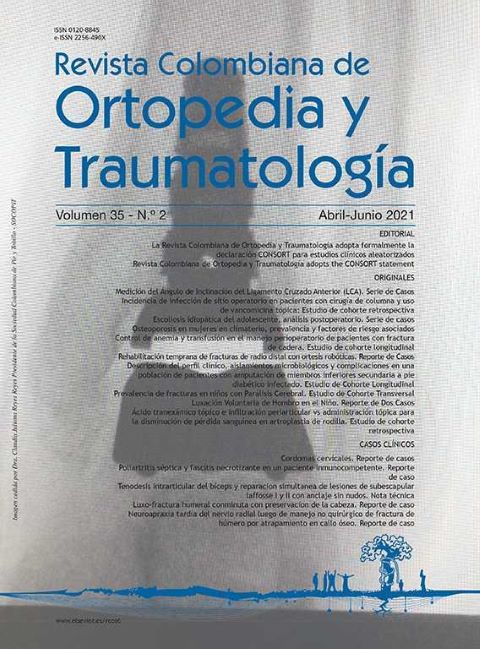Control of anemia and transfusion in perioperative management of patients with hip fracture. A Cohort Study
DOI:
https://doi.org/10.1016/j.rccot.2021.04.005Keywords:
hip fracture, hemoglobin, transfusion, intravenous iron, anticoagulation, anti-aggregationAbstract
Background: Aim of the study is to describe the elements associated with hip fractures about needs for transfusion of blood products and their risk factors, as well as their modification through preoperative treatment through the administration of intravenous iron.Material and methods: A Cohort study of 119 patients admitted for hip fracture was conducted. Detailed description of the protocol for the pre-surgical optimization of these patients, epidemiological data, analytical values, as well as data on intravenous iron administration and need for transfusion were collected.
Results: 31.09% of the patients were using platelet aggregation inhibitors and 21.85% were were using anticoagulants at the time of admission. The mean hemoglobin on admission was 12.5 g / dl. 43.2% were transfused during the hospital stay. In the analysis of risk factors for transfusion, we statistically demonstrated that both hemoglobin on admission (p < 0.001), as well as previous diagnoses of chronic anemia, arterial hypertension, and renal failure, are related to the need for intra-hospital transfusion. We found a statistically significant relationship between iron administration and the amount of packed red blood cells transfused (p < 0.005). Blood transfusion requirements were higher in extra-capsular than in intra-capsular fractures (p = 0.024).
Discussion: Patients with hip fracture frequently present low hemoglobin levels upon admission, as well as comorbidities and treatments that predispose to the development of perioperative anemia. Preoperative optimization of these patients by administering intravenous iron could reduce transfusion requirements. Evidence Level: II
Downloads
References
Ministerio de Sanidad, Política Social. Instituto de Información Sanitaria. En: Estadísticas comentadas: la atención a la fractura de cadera en los Hospitales del Servicio Nacional de salud. Madrid: Ministerio de Sanidad y Política Social,. http://www.msps.es/estadEstudios/estadisticas/docs/Estadisticas_comentadas_01.pdf; 2010.
Svedbom A, Hernlund E, Ivergård M, Compston J, Cooper C, Stenmark J, McCloskey EV, Jönsson B, Kanis JA. Osteoporosis in the European Union: a compendium of country-specific reports. EU review panel of the IOF. Arch Osteoporos. 2013;8(1-2):137. https://doi.org/10.1007/s11657-013-0137-0
González López-Valcárcel B, Sosa Henríquez M. Estimate of the 10-year risk of osteoporotic fractures in the Spanish population. Med Clin (Barc). 2013;140:104-9. https://doi.org/10.1016/j.medcli.2011.11.030
Rowlands M, Forward D, Sahota O, Moppett K. The effect of intravenous iron on postoperative transfusion requirements in hip fracture patients: study protocol for a randomized controlled trial. Trials. 2013;14:288. https://doi.org/10.1186/1745-6215-14-288
Cuenca J, García JA, Manrtínez AA, Solano VM, Modrego FJ. Seguridad y eficacia del hierro intravenoso en la anemia aguda por fractura trocantérea de cadera en el anciano. Med Clin (Barc). 2004;123:281-5. https://doi.org/10.1016/S0025-7753(04)74493-0
Hill GE, Frawley WH, Griffith KE, Forestner JE, Minel JP. Allogenic blood transfusion increases the risk of postoperative bacterial infection: a meta-analysis. J. Trauma. 2003;54:908-11. https://doi.org/10.1097/01.TA.0000022460.21283.53
Izuel-Rami M, Cuenca J, García-Erce JA, Gomez Barrera M, Carcelén J, Rabanaque MJ. Efectividad de distintas pautas de tratamiento de la anemia perioperatoria en pacientes ancianos con fractura de cadera. Farm Hosp. 2005;29:250-7.https://doi.org/10.1016/S1130-6343(05)73673-4
Parker MJ. Iron supplementation for anemia after hip fracture surgery: a randomized trial of 300 patients. J Bone Joint Surg Am. 2010;92:265-9. https://doi.org/10.2106/JBJS.I.00883
Garcia-Erce Ja, Cuenca J, Muñoz M, Izuel M, Martínez AA, Solano VM, Martínez F. Perioperative stimulation of erythropoiesis with intravenous iron and erythropoietin reduces transfusion requirements in patients with hip fracture. A prospective observational study. Vox sanguinis. 2005;88:235-43. https://doi.org/10.1111/j.1423-0410.2005.00627.x
Rognoni C, Venturini S, Meregaglia M, Marmifero M, Tarricone R. Efficacy and safety of ferric carboxymaltose and other formulations in Iron-deficient patients: A systematic review and network meta-analysis of randomised controlled trials. Clin Drug Investig. 2016;36:177-94. https://doi.org/10.1007/s40261-015-0361-z
Calleja JL, Delgado S, del Val A, Hervás A, Larraona JL, Terán A, Cucala M, Mearin F. Ferric carboxymaltose reduces transfusions and hospital stay in patients with colon cancer and anemia. Int J Colorectal Dis. 2016;31:543-51. https://doi.org/10.1007/s00384-015-2461-x
Bernabeu-Wittel M, Romero M, Ollero-Baturone M, Aparicio R, Murcia-Zaragoza J, Rincón-Gómez M, Monte-Secades R, Melero-Bascones M, Rosso CM, Ruiz-Cantero A. Ferric carboxymaltose with or without erythropoietin in anemic patients with hip fracture: a randomized clinical trial. Transfusion. 2016;56:2199-211. https://doi.org/10.1111/trf.13624





